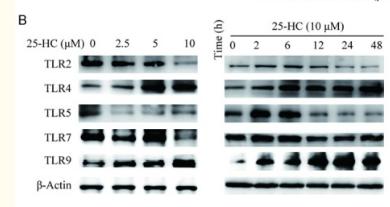TLR5 Antibody - #DF6575
| Product: | TLR5 Antibody |
| Catalog: | DF6575 |
| Description: | Rabbit polyclonal antibody to TLR5 |
| Application: | WB IHC |
| Cited expt.: | WB |
| Reactivity: | Human, Mouse, Rat |
| Prediction: | Chicken, Xenopus |
| Mol.Wt.: | 98kDa; 98kD(Calculated). |
| Uniprot: | O60602 |
| RRID: | AB_2838537 |
Related Downloads
Protocols
Product Info
*The optimal dilutions should be determined by the end user. For optimal experimental results, antibody reuse is not recommended.
*Tips:
WB: For western blot detection of denatured protein samples. IHC: For immunohistochemical detection of paraffin sections (IHC-p) or frozen sections (IHC-f) of tissue samples. IF/ICC: For immunofluorescence detection of cell samples. ELISA(peptide): For ELISA detection of antigenic peptide.
Cite Format: Affinity Biosciences Cat# DF6575, RRID:AB_2838537.
Fold/Unfold
FLJ10052; MGC126430; MGC126431; SLEB1; TIL 3; TIL3; TLR 5; Tlr5; TLR5_HUMAN; Toll like receptor 5; Toll like receptor 5 precursor; Toll-like receptor 5; Toll/interleukin 1 receptor like protein 3; Toll/interleukin-1 receptor-like protein 3;
Immunogens
A synthesized peptide derived from human TLR5, corresponding to a region within C-terminal amino acids.
Highly expressed on the basolateral surface of intestinal epithelia (PubMed:11489966). Expressed also in other cells such as lung epithelial cells (PubMed:11489966, PubMed:18490781).
- O60602 TLR5_HUMAN:
- Protein BLAST With
- NCBI/
- ExPASy/
- Uniprot
MGDHLDLLLGVVLMAGPVFGIPSCSFDGRIAFYRFCNLTQVPQVLNTTERLLLSFNYIRTVTASSFPFLEQLQLLELGSQYTPLTIDKEAFRNLPNLRILDLGSSKIYFLHPDAFQGLFHLFELRLYFCGLSDAVLKDGYFRNLKALTRLDLSKNQIRSLYLHPSFGKLNSLKSIDFSSNQIFLVCEHELEPLQGKTLSFFSLAANSLYSRVSVDWGKCMNPFRNMVLEILDVSGNGWTVDITGNFSNAISKSQAFSLILAHHIMGAGFGFHNIKDPDQNTFAGLARSSVRHLDLSHGFVFSLNSRVFETLKDLKVLNLAYNKINKIADEAFYGLDNLQVLNLSYNLLGELYSSNFYGLPKVAYIDLQKNHIAIIQDQTFKFLEKLQTLDLRDNALTTIHFIPSIPDIFLSGNKLVTLPKINLTANLIHLSENRLENLDILYFLLRVPHLQILILNQNRFSSCSGDQTPSENPSLEQLFLGENMLQLAWETELCWDVFEGLSHLQVLYLNHNYLNSLPPGVFSHLTALRGLSLNSNRLTVLSHNDLPANLEILDISRNQLLAPNPDVFVSLSVLDITHNKFICECELSTFINWLNHTNVTIAGPPADIYCVYPDSFSGVSLFSLSTEGCDEEEVLKSLKFSLFIVCTVTLTLFLMTILTVTKFRGFCFICYKTAQRLVFKDHPQGTEPDMYKYDAYLCFSSKDFTWVQNALLKHLDTQYSDQNRFNLCFEERDFVPGENRIANIQDAIWNSRKIVCLVSRHFLRDGWCLEAFSYAQGRCLSDLNSALIMVVVGSLSQYQLMKHQSIRGFVQKQQYLRWPEDFQDVGWFLHKLSQQILKKEKEKKKDNNIPLQTVATIS
Predictions
Score>80(red) has high confidence and is suggested to be used for WB detection. *The prediction model is mainly based on the alignment of immunogen sequences, the results are for reference only, not as the basis of quality assurance.
High(score>80) Medium(80>score>50) Low(score<50) No confidence
Research Backgrounds
Pattern recognition receptor (PRR) located on the cell surface that participates in the activation of innate immunity and inflammatory response. Recognizes small molecular motifs named pathogen-associated molecular pattern (PAMPs) expressed by pathogens and microbe-associated molecular patterns (MAMPs) usually expressed by resident microbiota. Upon ligand binding such as bacterial flagellins, recruits intracellular adapter proteins MYD88 and TRIF leading to NF-kappa-B activation, cytokine secretion and induction of the inflammatory response. Plays thereby an important role in the relationship between the intestinal epithelium and enteric microbes and contributes to the gut microbiota composition throughout life (By similarity).
Phosphorylated at Ser-805 by PKD/PRKD1; phosphorylation induces the production of inflammatory cytokines.
Phosphorylated at Tyr-798 upon flagellin binding; required for signaling.
Cell membrane>Single-pass type I membrane protein.
Highly expressed on the basolateral surface of intestinal epithelia. Expressed also in other cells such as lung epithelial cells.
Belongs to the Toll-like receptor family.
Research Fields
· Human Diseases > Infectious diseases: Bacterial > Pathogenic Escherichia coli infection.
· Human Diseases > Infectious diseases: Bacterial > Salmonella infection.
· Human Diseases > Infectious diseases: Bacterial > Legionellosis.
· Human Diseases > Immune diseases > Inflammatory bowel disease (IBD).
· Organismal Systems > Immune system > Toll-like receptor signaling pathway. (View pathway)
References
Application: WB Species: Human Sample: HepG2 cells
Restrictive clause
Affinity Biosciences tests all products strictly. Citations are provided as a resource for additional applications that have not been validated by Affinity Biosciences. Please choose the appropriate format for each application and consult Materials and Methods sections for additional details about the use of any product in these publications.
For Research Use Only.
Not for use in diagnostic or therapeutic procedures. Not for resale. Not for distribution without written consent. Affinity Biosciences will not be held responsible for patent infringement or other violations that may occur with the use of our products. Affinity Biosciences, Affinity Biosciences Logo and all other trademarks are the property of Affinity Biosciences LTD.
